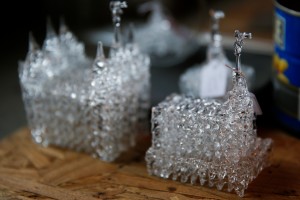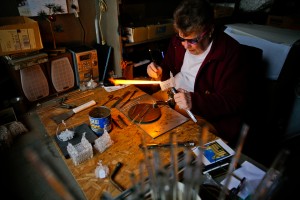
As the Provo City Center Temple nears its opening, one glassblower already has it created in glass.
Marge Rosebrook has been sculpting glass for almost 40 years, and for most of those years, she’s specialized in creating LDS temples. She estimates she has made more than 75,000 temples over that time, and shipped them to every continent on the globe except for Antarctica.
“And that’s only because there’s no temple there yet,” quipped Sarah Asay, her business partner.
Rosebrook sculpts or “stitches” all her temples from unleaded Corning glass in a small 8 by 8 foot workshop at the end of Asay’s driveway in Provo. Rosebrook is a unique type of glassblower — she said the old term is a “lampworker.” She does not hand blow her glass, but uses a heat lamp that pumps heat and air out of the end, so she can work quickly and add the many intricacies to her sculptures.
To stitch her temples, Rosebrook starts with a small glass rod in her left hand, and a slightly bigger rod in her right. She runs the bigger rod through the flame to melt it, and then makes looping stitches onto the smaller rod. She builds rows until she has a wall or ceiling piece, then repeats the process for the rest of the piece. When she adds columns and spires, she uses a coil stitch to attach the rods.
Rosebrook is able to work bare-handed, with her fingers fairly close to the flame, even though the fire shooting from her lamp is more than 1,000 degrees, because the glass conducts light but not heat. But she always wears unique glasses made specifically for glass blowers that she attaches to her regular eyeglasses. The lenses protect her sight — she could go blind without them because of the brightness of the flame — and they also allow her to see directly into the flame so she can see exactly what the glass is doing.

Details are very important to Rosebrook. She has never been to most of the temples she’s sculpted, but she uses multiple pictures, from multiple angles, to get her details exact. She can tell you the unique features of every temple, such as how the Manti and Logan temples are almost identical in structure, but one (Manti) has two squared off columns on one end. She loves when she finds an aerial shot for a temple, because then she can check if it really is square or rectangular — something that is very difficult to ascertain with the bigger temples just from ground-level shots.
All Rosebrook’s temples are handmade, but she makes them as uniform as possible, so “every Salt Lake Temple looks like the Salt Lake Temple,” she said. As she stitches, she makes small but important adjustments, correcting a loop here or leveling off an edge there.
“I always end up with a slant,” she said about one of the walls she was creating for a Manti Temple sculpture. “Luckily, glass is something you can go back and fix.”
When Rosebrook started creating temples, there were only about 20 LDS temples worldwide. That number slowly increased, and Rosebrook kept up, finishing her own glass temples just about when the real temple was dedicated and opened. That pattern followed until Gordon B. Hinckley became the LDS Prophet in 1995, and put a new emphasis on temple building — going from about 47 to 100 temples in just 15 years.
“President Hinckley went nuts (building temples), and I just about went nuts too,” she said of that time.
Rosebrook will be 73 in just two weeks and considers herself semi-retired, only making temples as they are ordered on her site, templesaroundtheworld.com. But handcrafted art is seeing a resurgence in recent years, and she would love to teach someone her technique, so they can carry on the craft.
Still, she doesn’t plan on quitting anytime soon.
“I enjoy doing it, and I’ll do it for as long as I can. It gives me something worthwhile to do, and as long as people buy them, I’ll make them,” she said.




